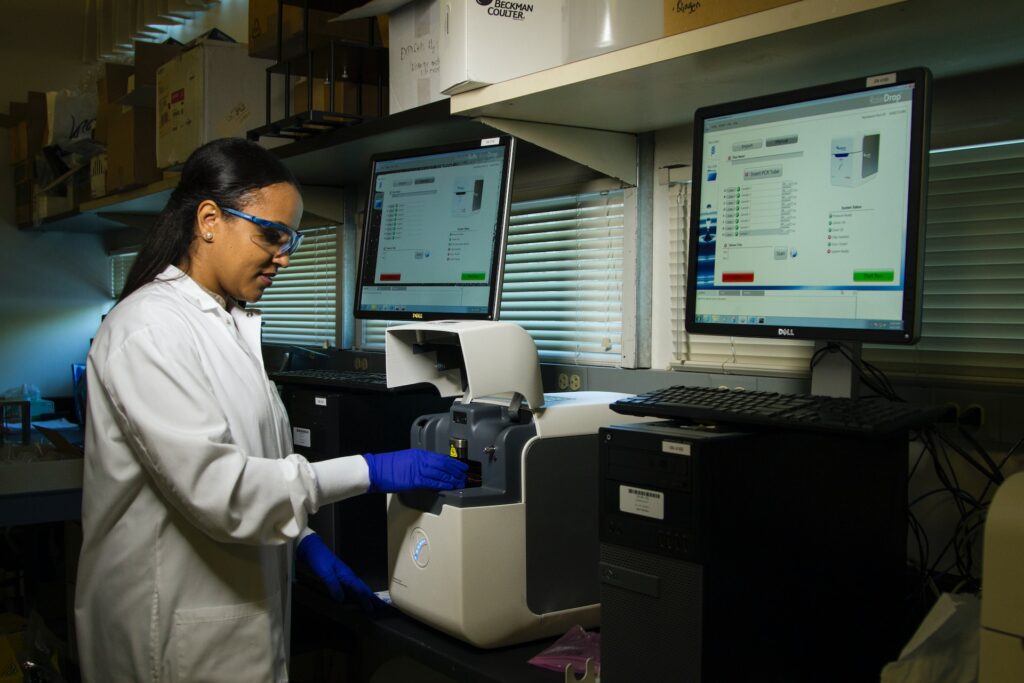Healthcare data integration has become a vital element of modern health systems. The opportunity to gain data from sources like EHRs and telehealth devices allows healthcare companies to get a more accurate and informative picture of the patient’s health. This allows them to provide better care, cover the latest patients’ needs, and streamline workflows. According to this report, the number of different electronic methods to gather and send medical data grew from 3.3 to 3.8 during the forecast period.
Easy and instant access to all patient data has long been an option, yet the COVID-19 pandemic made this a must-have for any clinics looking to provide better services for their patients. In fact, the demand for systems like EHR, more IoT devices, the development of blockchain-based healthcare marketplaces, and the rise in the popularity of telemedicine devices made it possible for clinics to gain more data than ever before.
Although data integration can bring a huge change into the entire healthcare ecosystem, it only drives improvements when properly implemented. Your clinics may already have access to data, yet you don’t aggregate it from all available sources. Let’s dive into the process of data integration in healthcare in 2023, where we share best practices and tips to know.
Why is Healthcare Data Integration so a Big Deal?
Data integration means collecting data from systems. Clinical data integration allows interoperability, meaning systems can “speak” to each other. This seamless connection across all available systems and devices can be critical in achieving a holistic patient view of their healthcare journey. The global HIE (Health Information Exchange) market is suggested to reach $2174 million by the end of 2028. Now the HIE market is estimated at $1400 million.
Medical data integration and interoperability allows:
- A complete overview of patient data extracted from disparate sources;
- Availability of all patient diagnoses, medical records, and treatments for accurate analysis;
- Minimize mistakes in treatments and improve care.
Research shows that more than 35% of patients see over five healthcare providers in a year. And in most cases, doctors don’t have a full record of a patient’s medical history, so they try to recreate it by asking a million questions – and this still doesn’t help in getting all the information needed. In addition, the resource found out that approximately 15%, or about $600 billion, of the entire US healthcare spending, is caused by fraud, waste, and abuse of information. And one of the key reasons for that is the inability to share data between systems, stakeholders, and parties in the healthcare system.
What are the Benefits of Healthcare Data Integration?
New standards in the healthcare domain drive the need for seamless data exchange. This process has been shown to reduce the cost and complexity of developing interfaces between different systems.
The key element of the modern healthcare system is data interoperability. With so much talk about this world, not everyone knows its importance. Proper system integration in healthcare must offer simplicity for users, meaning systems must not only exchange data but also offer it to users in an understandable interface.
Data interoperability is a large concept that covers the exchange and presentation of medical data, uniform safeguarding of data security and safety of patient confidentiality, and uniform assurance of an established degree of system service quality. Simply put, data interoperability is the ability of several technology systems and software to communicate, send data, and use this information.
The tech interoperability in this industry is partly organized by the Health Level 7 (HL7) standards. This set of standards offers guidelines on how the data should be structured.
Get a free consultation!
Thinking about data integration in healthcare? Our company is ready to handle the full cycle of app development or join you at any stage of the project.
Let’s talkRead more about HL7 standards here
One of the key benefits of data integration in healthcare has been shown to improve a hospital’s view of patient data. The ability to use the entire patient’s history reduces operational costs, speeds up the process, and improves overall patient care.
It also helps operators to develop more efficient interfaces between different systems from various vendors. Health data is made up of multiple elements from several data sources. Yet, this information should also be unified by using specific standards and terminology mapping.
Clean data integration also allows to:
- Clarify the information about medications used within the organization to automatically map specific data;
- Filter medical data using industry-standard codes to standardize tests, observations, panels, as well as assessments tests;
- Combine and collect the entire patient’s medical history to organize seamless data sharing and use the data accordingly;
There are many other benefits of data integration that make the healthcare industry thrive and grow rapidly, yet these are key ones.

Healthcare Data Integration Challenges
1. Lack of Standardization
There is a huge challenge in integrating data into the healthcare system – a lack of standardization. If you want your integrated data to bring value instead of fraud and costly mistakes, your development team should ensure it is standardized within all systems.
It isn’t an easy task; it requires knowledge of the industry. In addition, various companies have different systems and formats they use to store the data, meaning there is no simple and practical way for everyone to integrate data.
Solution:
You can resolve this issue by establishing common standards for data sharing, access to information, and overall management. That is why developers organizing your data integration should know the industry’s standards and be able to communicate with committees or councils responsible for them.
2. Fragmentation
Another issue that developers can face when integrating data into healthcare systems is fragmentation. Fragmented systems occur when different parts of your company work independently from each other, which usually comes with a lack of communication, management, and coordination. This can lead to costly mistakes, including duplicate data entry, inconsistent diagnosis, inaccurate medications, as well as difficulty in sharing data within departments.
Solution:
It can be resolved by developing a functional and error-free IT strategy that collects all parts of the organization and organizes its seamless communication.
3. Lack of Resources
One of the biggest data integration challenges in healthcare is the lack of resources. To make the process smooth and effective, your clinic or a healthcare organization needs people with expertise in both – development and healthcare. While the market offers a vast range of options, not every provider will have enough skills to realize the idea in a proper way.
Solution:
It is always recommended to look for development companies offering healthcare data integration services that have the relevant expertise that they can show. It isn’t enough to just say that the provider has the experience; you should check reviews on trusted resources like Clutch, Upwork, or video testimonials from clients. In addition, check how the team communicates since it also affects the success of the process.
4. Security Risks
And the last key issue you may face during the process is security challenges. The data stored and shared between systems may become a target for hackers. This includes intentional and unintentional attacks as well.
Solution:
Implementing proper security measures or organizing data integration through blockchain can prevent you from most types of attacks. It’s also vital to educate the staff and users about security risks and how to secure themselves from common types of attacks. You will also need to implement regulations established in the industry, such as HIPAA.
6 Tips for Successful Data Integration in healthcare
1. Design the System to Gain the Right Data
You should always start by asking the right questions. This will help your data teams to learn more about the data your healthcare system needs and redesign it or integrate technology accordingly. Start with the following questions:
- Do you have an Electronic Health Record (EHR) or an Electronic Medical Record (EMR) for all patients? If yes, does this system cover your needs? Or maybe it needs improvements?
- What does your staff need that existing systems don’t offer?
- What are the KPIs your current systems have? Is it to improve the quality of care? Improving the quality of patient care? Should it help reduce operational costs? Or maybe it is designed to better use medical equipment?
2. Start From Cloud-Native and APIs
The large volume of data you are going to use instantly means using the cloud. Alternatively, the vast range and geographical distribution of medical data mean the use of API-enabled architectures. APIs are widely used for that purpose since they help to standardize data connection.
In most cases, healthcare data is fragmented, which we already described as an issue in integration. Since it usually comes from many sources, a cloud-native, hybrid solution can be a good decision.
3. Learn FHIR Standards
Your development team can organize the data into standard formats like Fast Healthcare Interoperability Resource (FHIR). It is the protocol existing in the healthcare industry used for joining disparate systems together, developed with the complexity and sensitivity of medical data in mind. This protocol’s standards also define how to use APIs.
4. Allow Analytics
It is also recommended to connect your data to available analytic tools. However, it is essential to guarantee that the connection between databases is secure and scalable, so you don’t need to worry about further extensions and security risks.
5. Organize Proper Access and Data Management
Data-driven decisions are crucial in most industries, yet it is especially important for healthcare. However, in most cases, the decision-makers do not have instant and easy access to the information they need for these decisions.
You need to organize data and give access to needed people. Managing information in healthcare is vital, so you should choose people with instant access to data stored in the servers for easy and smooth communication.
6. Ensure Data Security
Sharing medical data is also risky because of its sensitivity. That is why the key thing here is that healthcare companies have to be compliant with data privacy regulations. There are many regulations that have to be followed, including HIPAA, HL7, and others, depending on the country you live in.
Healthcare Data Integration Company
Interexy is the leading healthcare development company. We offer end-to-end healthcare app development services for clinics and healthcare organizations seeking more secure, efficient, and stable data sharing.
Thanks to the well-thought-out hiring process established years ago, each client gets specialists with specific expertise and skills, meaning only top-notch results by the end of the process. We make it easy for companies to choose how to cooperate with us – hire developers just for healthcare data integration, outsource the entire process, or get a dedicated team with full resources within 10 business days.
Wrapping Up
With the demand for more efficient and quality care, clinics and healthcare companies should improve their processes to offer better services for their patients. Data sharing has always been a question for this industry, thanks to the large volume of healthcare data integration standards and security issues. There is a solution now, yet it requires resources and skills to organize seamless and protected data sharing for better care. Book a free call with our experts to get details on your specific case!
Easy and instant access to all patient data has long been an option, yet the COVID-19 pandemic made this a must-have for any clinics looking to provide better services for their patients. In fact, the demand for systems like EHR, more IoT devices, the development of blockchain-based healthcare marketplaces, and the rise in the popularity of telemedicine devices made it possible for clinics to gain more data than ever before. If you’re looking for a telemedicine app development company to overcome the biggest medical app development challenges, don’t hesitate to get in touch to find out how we can help you.
- Statista reports that the Healthcare IoT market is suggested to reach US$93.82bn in 2023
- The same source reports that 55% of healthcare apps will have adopted blockchain for commercial deployment by the end of 2025.
FAQ on Healthcare IT Integration
What is data integration in healthcare?
Healthcare data integration refers to the process of consolidating and merging diverse health-related information from various sources, enabling a unified view of patient data for improved decision-making and enhanced healthcare delivery.
What are the benefits of healthcare data integration?
The benefits of data integration in healthcare are interoperability, seamless data exchange, accuracy of diagnosis, reduced operational costs, and care quality. The key element of the modern healthcare system is data interoperability.
What are the types of information sources for data integration in IT healthcare?
Data Integration in healthcare collects information from a vast range of sources, including surveys, lab results, medical records, vitals, peer-reviewed literature, quizzes, and more.
How much does it cost to integrate data in healthcare systems?
The cost depends on many factors, including the complexity of the existing systems, the volume of data, the number of resources, timelines, and others. It is best to book a free call so we can provide an accurate estimation.
Subscribe for Updates!
New product features, the latest in technology, solutions and updates.
Latest articles

The Ultimate Technical Guide to DAO Development
DAOs are built on blockchain technology, ensuring security, transparency, and immutability, providing a decentralized and trustless environment where stakeholders can participate in decision-making processes without intermediaries.

Machine Learning in Business: Opportunities & Best Practices
Machine Learning is a subset of Artificial Intelligence that involves using algorithms and statistical models to enable computers to improve their performance on tasks through experience.

Your Ultimate Roadmap to Compliant Blockchain Adoption
Ensuring regulatory compliance in blockchain adoption mitigates risks and fosters a secure, legal, and trustworthy environment for all stakeholders.






